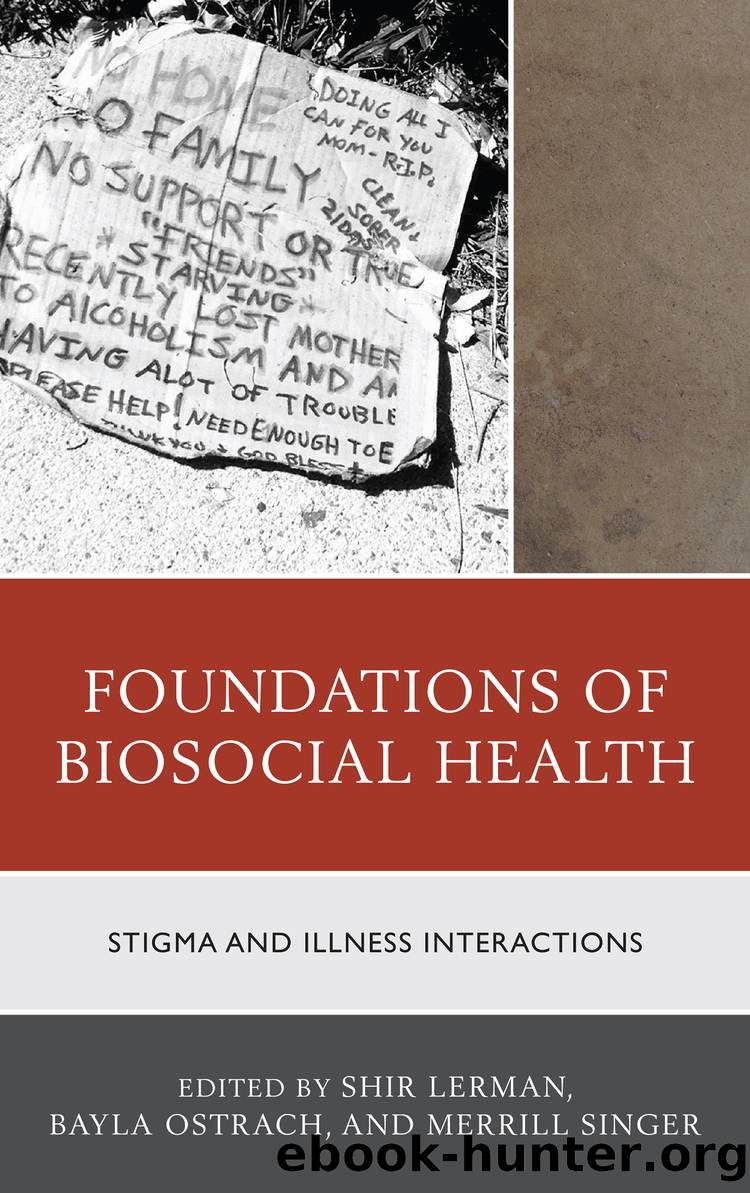Foundations of Biosocial Health: Stigma and Illness Interactions by Shir Lerman;Bayla Ostrach;and Merrill Singer

Author:Shir Lerman;Bayla Ostrach;and Merrill Singer [Singer, Shir Lerman;Bayla Ostrach;and Merrill]
Language: eng
Format: epub
Publisher: Lexington Books
Published: 2017-04-25T16:00:00+00:00
Chapter Five
The PHAMILIS Stigma Syndemic Among Homeless Women
Ruthanne Marcus and Merrill Singer
The public perception of homelessness is fraught with negative images and stereotypes that can be said to constitute a total stigma environment for people who are without homes. Living under these conditions has identifiable consequences for the health and well-being of people who are homeless, including, as described in this chapter, suffering from a distinctive stigma syndemic that increases the health burden of those deemed to fit the constructed social category of being homeless.
Despite endurance of adverse portrayal and discrimination as an identifiable category of people, in fact, people who are homeless are not a fixed or undifferentiated population nor is homelessness a stable unchanging condition. Rather, the face of homelessness has been transformed since the images of the Bowery and Skid Row were etched in the publicâs imagination during the early twentieth century, a gallery of images that depicted homeless, drunk men gathering aimlessly on urban street corners (Hopper 2003; Rossi 1989; Wagner 1993). In the 1960s, homeless people in the United States, predominantly older white men, were living in inexpensive single-room occupancy (SRO) hotels, mission shelters, or temporarily in jails. In the 1950s and 1960s only 3 percent of the homeless population were women (Bassuk 1993). Furthermore, in the 1960s, mental health reforms closed many psychiatric facilities and forced mentally ill persons onto the street, leaving them to sleep in the cold, in doorways, on park benches or culverts, under bridges, or in other outdoor or nonpermanent locations (Rossi 1989). In the 1970s, economic stagnation, rising inflation, decline in real wages, the significant loss of manufacturing jobs, and high unemployment levels led to a rise in the number of homeless people (Glasser and Bridgman 1999). As Skid Rows vanished in many large cities, the homeless population also declined, as many pensioners moved to subsidized housing for the elderly. The composition of the homeless population changed significantly in the 1980s when the gentrification of urban areas created a lack of affordable housing and an increase in companies with unattainable high-tech jobs requiring specialized education forced people onto the streets and other nonpermanent locations (Burt 1992; Hopper 1988; Rossi 1989). Also during this decade, state and federal welfare programs were reduced, real estate prices rose, lower-paid service-industry jobs and part-time work increased, affordable housing decreased, and the departure of manufacturing industry reduced available well paid employment (Burt 1992). Due to the convergence of all these factors, at this time there was a large increase in the number of visibly homeless men and women on the streets making them much harder for polite society to ignore (Burt 1992; Rossi 1989). During the period 1985â1990, unlike in earlier decades, the proportion of homeless women came to equal the number of homeless men (Lehmann et al. 2007).
Welfare reform during the 1980s and 1990s further altered this population as younger women, mothers and their children were forced to seek residence on the streets, in shelters, subway stations, bus stations, and other public places (Glasser and Bridgman 1999; Rossi 1989).
Download
This site does not store any files on its server. We only index and link to content provided by other sites. Please contact the content providers to delete copyright contents if any and email us, we'll remove relevant links or contents immediately.
| Administration & Medicine Economics | Allied Health Professions |
| Basic Sciences | Dentistry |
| History | Medical Informatics |
| Medicine | Nursing |
| Pharmacology | Psychology |
| Research | Veterinary Medicine |
Machine Learning at Scale with H2O by Gregory Keys | David Whiting(3647)
Fairy Tale by Stephen King(2956)
Will by Will Smith(2582)
Hooked: A Dark, Contemporary Romance (Never After Series) by Emily McIntire(2424)
Rationality by Steven Pinker(2151)
Friends, Lovers, and the Big Terrible Thing by Matthew Perry(2005)
The Becoming by Nora Roberts(1922)
Love on the Brain by Ali Hazelwood(1820)
HBR's 10 Must Reads 2022 by Harvard Business Review(1698)
The Strength In Our Scars by Bianca Sparacino(1696)
A Short History of War by Jeremy Black(1672)
Leviathan Falls (The Expanse Book 9) by James S. A. Corey(1525)
515945210 by Unknown(1522)
Bewilderment by Richard Powers(1450)
443319537 by Unknown(1396)
A Game of Thrones (The Illustrated Edition) by George R. R. Martin(1374)
The Real Anthony Fauci: Bill Gates, Big Pharma, and the Global War on Democracy and Public Health (Childrenâs Health Defense) by Robert F. Kennedy(1337)
The 1619 Project by Unknown(1321)
Fear No Evil by James Patterson(1252)
